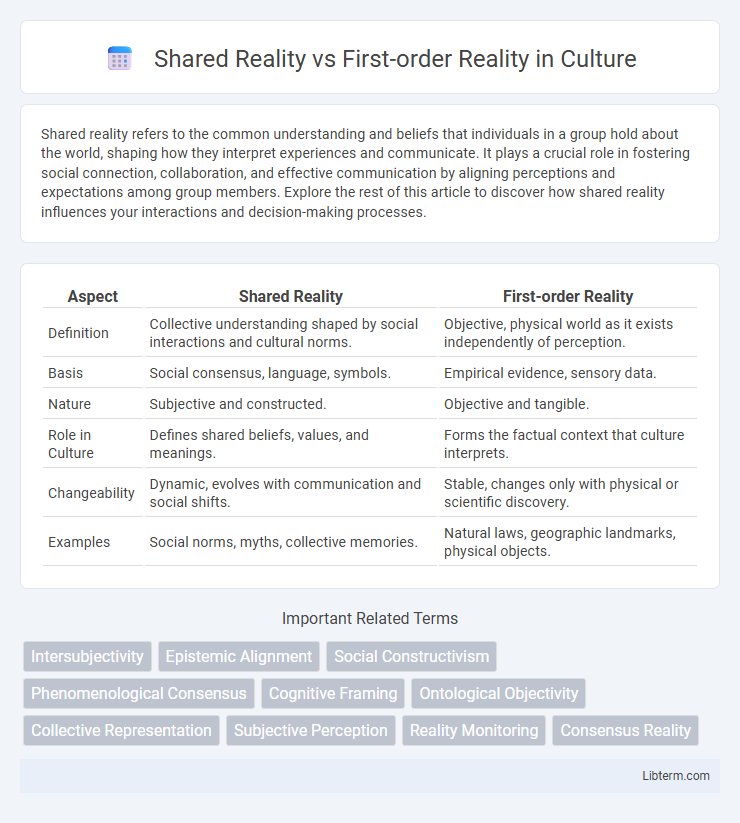Shared reality refers to the common understanding and beliefs that individuals in a group hold about the world, shaping how they interpret experiences and communicate. It plays a crucial role in fostering social connection, collaboration, and effective communication by aligning perceptions and expectations among group members. Explore the rest of this article to discover how shared reality influences your interactions and decision-making processes.
Table of Comparison
| Aspect | Shared Reality | First-order Reality |
|---|---|---|
| Definition | Collective understanding shaped by social interactions and cultural norms. | Objective, physical world as it exists independently of perception. |
| Basis | Social consensus, language, symbols. | Empirical evidence, sensory data. |
| Nature | Subjective and constructed. | Objective and tangible. |
| Role in Culture | Defines shared beliefs, values, and meanings. | Forms the factual context that culture interprets. |
| Changeability | Dynamic, evolves with communication and social shifts. | Stable, changes only with physical or scientific discovery. |
| Examples | Social norms, myths, collective memories. | Natural laws, geographic landmarks, physical objects. |
Understanding Shared Reality: A Definition
Shared reality refers to the mutual understanding and common knowledge established between individuals through communication, allowing them to align perceptions, beliefs, and intentions. Unlike first-order reality, which is grounded in objective facts and physical existence, shared reality emphasizes the subjective agreement that shapes social interactions and collective meaning. This concept highlights how people co-create a consistent worldview, facilitating collaboration and social cohesion.
What is First-order Reality?
First-order reality refers to the objective world as it exists independently of human perception or interpretation, encompassing physical facts and tangible phenomena. It is distinguished from shared reality, which involves the collective beliefs, interpretations, and social agreements that shape how people understand and interact with the world. Understanding first-order reality is essential for grounding knowledge in empirical evidence and distinguishing it from subjective or socially constructed realities.
Key Differences Between Shared and First-order Reality
Shared reality refers to the collective understanding and interpretations constructed by groups through communication and social interaction, while first-order reality denotes the objective, physical world as it exists independently of perception. Key differences include that shared reality is subjective, varying across cultures and individual experiences, whereas first-order reality is consistent and observable regardless of beliefs. Shared reality shapes social norms, behaviors, and meanings, whereas first-order reality forms the empirical basis for scientific inquiry and factual verification.
Origins of Shared Reality in Human Society
Shared reality originates from humans' innate need to align perceptions and beliefs within social groups, enabling coordinated actions and cultural development. This collective understanding is constructed through language, social interaction, and shared experiences that transform individual perceptions into a common framework. Neurocognitive mechanisms, such as theory of mind and social cognition, facilitate the creation and maintenance of shared realities by promoting empathy and perspective-taking.
How First-order Reality Shapes Perception
First-order reality consists of objective facts and tangible events that exist independently of individual beliefs, forming the foundation of sensory experience. This concrete reality shapes perception by providing a consistent framework through which individuals interpret sensory input and verify information. Variations in perception arise when different interpretations of first-order reality are influenced by cognitive biases, cultural backgrounds, or prior experiences.
The Role of Language in Constructing Shared Reality
Language serves as the primary tool in constructing shared reality by enabling collective understanding and coordination of experiences among individuals. Through verbal communication and symbols, language shapes perceptions, conveys cultural norms, and reinforces social identities that maintain a consistent shared reality across communities. This dynamic process allows first-order reality--direct sensory experiences--to be interpreted and integrated into a socially constructed framework that governs group behavior and expectations.
Psychological Impacts of Participating in Shared Reality
Participating in Shared Reality strengthens social bonds by creating a mutual understanding that aligns individuals' perceptions and emotions, enhancing feelings of belonging and validation. This psychological alignment reduces cognitive dissonance and fosters collective identity, which can improve mental well-being and resilience in social contexts. Shared Reality also facilitates cooperative behavior and effective communication, contributing to emotional support and a sense of security within groups.
Challenges of Navigating Between Shared and First-order Realities
Navigating between shared reality and first-order reality involves complex challenges such as misalignment in perceptions, where individuals' subjective experiences clash with collectively accepted truths, leading to communication breakdowns. Cognitive dissonance often arises when first-order experiences contradict shared beliefs, causing resistance to acknowledging alternative perspectives. Effective navigation demands fostering empathy and employing critical thinking to reconcile individual realities with group consensus, ensuring coherent understanding and collaboration.
Shared Reality in the Age of Digital Media
Shared reality in the age of digital media is shaped by collective beliefs and shared interpretations of information across platforms like social networks and online communities. Digital media amplifies the construction of shared realities by enabling rapid dissemination, algorithmic curation, and the formation of echo chambers that reinforce group-specific narratives. This dynamic influences social norms, political discourse, and individual perceptions, often blurring the distinction between subjective shared realities and objective first-order realities.
Bridging the Gap: Finding Balance Between Realities
Bridging the gap between shared reality and first-order reality involves recognizing the interplay between subjective experiences and collective perceptions, fostering communication that validates individual truths while aligning them with communal frameworks. Developing empathy and active listening enhances mutual understanding, enabling individuals and groups to co-construct meaning that respects both personal authenticity and social consensus. Effective balance emerges through adaptive dialogue and integrative cognition, which reconcile divergent viewpoints without negating the legitimacy of either reality.
Shared Reality Infographic

 libterm.com
libterm.com